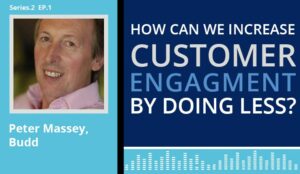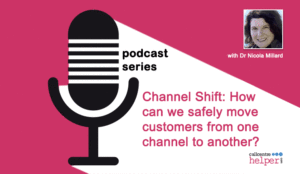The Contact Centre Podcast: Series 4 Episode 2
Erica Mancuso, a service transformation expert, discusses some of the most promising technologies that are emerging within the contact centre industry.

In our conversation, we also talk about using tools to increase advisor engagement, getting more out of your existing software and creating a business case for contact centre technology.
To listen to the podcast directly from this web page, just hit the play button below:
The Contact Centre Podcast – Episode 20:
Contact Centre Technology: Where Should I Invest?
This podcast was made possible by our sponsor Talkdesk.
Podcast Time Stamps
- 1:43 – Improve Customer Experience
- 4:28 – Advisor Experience
- 8:50 – AI
- 10:42 – Reducing Operational Costs
- 14:06 – Other Exciting Technologies
- 18:47 – Creating a Business Case
Here is a Transcript to the Podcast
Charlie Mitchell: So the first question that I want to ask you today is: which technologies that are entering the contact centre right now most excite you in terms of improving the customer experience?
Erica Mancuso: Wow. There’s a lot out there. All the buzz is of course around artificial intelligence, robotic process automation, and chatbots, we all know that. I’m really a big fan of using technology like that to handle the repetitive or the really time-consuming things and then use our agents for the value-added work. The things like building relationships or driving product adoption, that’s what customers care about most, and that’s really where you get some wins in terms of impacting the customer experience.
Erica: I think there’s a lot of other things out there that could really help improve the customer experience as well, like virtual assistants. I read recently that by 2023, customers are going to prefer using speech interfaces like that to initiate 70% of self-service interactions, so that’s a huge increase in just a few years.
Erica: I think also leveraging data. Technology doesn’t always need to be visible to customers to make an impact. Love the notion of using data to better meet our customers’ needs, and now more than ever, we have better insights into their journeys with our companies. We know how they use our products, we know where they’re getting stuck, we no longer need to guess or survey the heck out of them, we know.
And I think that there is a ton of opportunity to leverage that information to really make some improvements to the customer experience. One example of that is if a client calls your company and they’re maybe trying to use your technology product, but they’re getting stuck. Previously, the agent would have to ask, “Where are you getting stuck? Describe this to me. What’s happening?” We shouldn’t need to ask our clients that, we should know by the time they interact with us where they’re getting stuck.
And so, we could take that kind of data and analytics and apply it in a situation like that so that it’s a much easier transaction for the customer in a situation like that.
Charlie: I think there’s lots of really interesting points there. Using data is one that particularly sticks in the mind for me, and combining that with AI, because another example that I was going to give was skill-based routing, and I’ve actually seen predictive-routing strategies that predict NPS scores, so net promoter scores between advisors and customers, and then the customer is routed through to the advisor who they’ll likely have the best interaction with just through the use of data and AI, and I think that was a really interesting combination.
And another focusing again on the AI – sorry to keep bringing it back to this – but robotic process automation is another technology which I think is particularly interesting at the moment for mechanizing many of the activities required to resolve a customer query. But how do you think that this technology can also be used to better the advisor experience?
Erica: Well, I think it’s very much related to the customer experience as well. I think that, I agree with you, it’s probably one of the most promising technologies out there for agents, but like anything, it’s how you blend the technology with the people in the process. And you have to be careful because there’s always potential for this to backfire and have a negative impact, both on the agent and on the customer experience.
So you need to make sure you design it well and it’s meeting customers’ needs, otherwise it’s going to be completely counterproductive. I know that sounds obvious, but that’s something we need to keep in mind when we’re implementing technology. I’d say look at all the repetitive tasks your agents are doing, and also, where are their biggest time drains? And consider automating those processes first, and then you can always build there.
Use the data, but you can also ask your agents how they spend their time, and you probably have an idea of the kinds of tasks that they just don’t like completing. Those are good areas that you could consider automating. If they spend too much time identifying problems or documenting cases, for example, this might be a good place to start with automation. But in my experience, agents would rather do the value-added work, the things that are really meaningful for customers, and not the repetitive tasks anyway.
You can even consider designing a blended experience that has hand-offs between the bots and the agents and some of that automation. So use the technology, you’ll free up the agents, and then they can focus on the more impactful work like the things that are value-added for customers, and I think your employees are going to be much happier as a result of that as well.
Charlie: I really like that idea of looking at the time drains from an agent’s perspective. I think that’s really interesting, and one of those time drains to add to the list that you put there was maybe improving after-call work, which for those of us who don’t know, is the process after a call where the advisor makes a note of the contact reason and the call outcomes and then schedules follow-ups, and much of those tasks can be automated to a large extent by robotic process automation. So I think yeah, it’s an interesting technology and I think one to really keep an eye on.
And then we’ve discussed a lot as well about the agent and advisor or advisor experience. So what other technologies do you think are really helpful in improving that?
Erica: I’m always interested in the technology that enables us to work smarter. The demands that we’re placing on our agents just keep growing, and the customers’ expectations of our agents are getting higher and higher, so anything that helps our agents to work smarter is going to be a good investment. And I’m not even sure it needs to be anything shiny and new, but what’s really helpful is having technology in place, maybe that has contextual routing, like you said earlier, to get the ticket to the right agent as quickly as possible, using that context then to empower the agent to resolve the issue or answer the question quickly and easily.
I think our organizations have more information now than we ever have before, but it often exists in silos, and as a result, your agents might feel like they have to hunt down information cross-functionally. So, also any technology that helps to build these bridges across your organization so that your agents can serve customers is probably a good technology as well.
Charlie: Yeah, I think that point about silos is really interesting, and you think when you walk into a call centre nowadays how many different systems that advisors are made to use. It can be in the double digits, and I think that’s also why another technology which we could also discuss is smart desktops so navigation is really easy.
So I think technologies, as you said, and smart desktops really could have a big influence on the advisor experience as well as maybe other technologies, such as wireless headsets or Agent Assist, which is quite an interesting concept, actually. And for anybody who hasn’t heard of this, the idea is that a chatbot sits side-by-side with an advisor and suggests things to the advisor to pass on to the customer, so it helps the advisor and not the customer, and it helps to train the bot to put on the front end at the end of the process, which I think was quite an interesting idea.
And that’s another interesting innovation that’s closely linked with AI. And I just quickly want to get your opinion on this, Erica. Just how big an impact do you think AI will have on the contact centre in the next 10 years or so?
Erica: Oh gosh. I think our contact centres are going to be built on AI going forward. And I think it gets to this point where that’s going to be the initial interaction that your clients are having with your organization, and I think it’s going to be kind of the face of your company. And then from there, you’re going to be using your people a little differently to create those great experiences for your customers.
But I think a huge transformation is coming. We’re kind of on the forefront of it right now, but I think you’re going to see a lot of progress in the next 10 years especially in that regard.
Charlie: Yeah, it’s definitely when you see all these reports coming out saying that, “Will it take over contact centre jobs or not?” All this new AI technology. And I don’t think it will actually, in my opinion, well, for the time being, because technology is mostly being installed to enhance the advisor experience now within the leading contact centres. Is that what you’re seeing?
Erica: Yes. That is exactly what I’m saying. I think you’re going to see a shift in the agents’ skill set because you’re going to offload a lot of those repetitive things and the time-consuming things, and that’s going to allow your agents to really work a little bit differently. And the job descriptions, the job of a support agent, I think, is going to change a lot in the future as a result of the technology that we’re seeing become more prevalent in the contact centres right now.
Charlie: Yeah, I think those job descriptions for the future, it would be very interesting to see a job description of a call centre agent in 10 years’ time or perhaps even less than that.
But moving on from a topic of looking into the future to one maybe looking a bit backwards, because there are still lots of great technologies that contact centres are using to reduce operational costs. So which technologies would you point these organizations to which have this goal?
Erica: Yeah. I think the technologies that really enable that context-rich self-service, that either help deflect cases or help your agents be more proficient, I think those are really, really solid technologies right now. They’re combining AI kind of alongside of your knowledge base and really making it a better experience, both for customers and your support agent.
There’s a lot of options for tools out there. I think everybody’s got to do their due diligence to determine which ones best meet their needs. And I think it’s easy to become enamoured with all the flashy new technologies, but you’ve got to build it from a firm foundation first.
Charlie: Yeah, I think those self-service apps, as you say, are particularly interesting. I was actually quite interested to know how AI is being used in those self-service apps, do you have any kind of insights into how that’s being done?
Erica: Yeah. I don’t know all the mechanics behind it, but what it’s doing is it’s kind of taking what it’s already learned and serving up results that best meet the customer’s needs based on kind of where they are in the product, what things they’ve done until that point somewhere in the technology product. So it’s really trying to get smart about getting the right information to the customer at the right point in their journey.
Charlie: Yeah. I think that’s a very interesting point, and finding the time in the journey to pop up a self-service option on the screen or something, or maybe even use a self-service app to put a notification through on the phone of the customer or something like that. I think it’s a very interesting idea and I think as well, looking at other technologies to reduce operational costs, I think for me, we look a lot into WFM, so workforce management systems and real-time dashboards, which I think are quite underappreciated in terms of ensuring that managers don’t make any knee-jerk decisions in terms of resource planning, which I think is also great.
Then there’s also a classic, which is call scripting. There’s actually lots of software out there now where we can add additional visual flows on advisor desktops to help speed up conversations without impacting call quality. And that raises an interesting question, actually. So, Erica, do you think that scripts still have their place in the modern contact centre with these new technologies?
Erica: I’ve never actually been a fan of scripts. I’m a fan of putting some guardrails in place and letting your contact centre agents have a person-to-person conversation within those guardrails. I feel like scripts come across as a little disingenuous, and customers don’t really love feeling like they’re being read a script. So no, let’s get rid of scripts and let’s put the guardrails in place. And I think some of the tools that you were describing there probably do just that. They’re saying, “Here’s kind of the things you want to hit on as you’re having this discussion. Here’s how you move this forward,” but they’re really guardrails and not scripts.
Charlie:Yeah, that’s very true. It’s more putting the guardrails, as you say, or guidelines in place without having the word-for-word conversation, which I think is very interesting. And now, before we move on to another different topic of creating business cases for these technologies, I just wanted to ask if there’s any other technologies that really excite you that we maybe haven’t discussed in much detail here?
Erica: Yeah, I think there’s this whole notion, and it’s not a new technology, but you’ve got to get the right mileage out of the technology that you already have. And you’ve got to be really firm, like I said before, on your fundamentals before you start to move from there. When you try to implement a new technology, you’re looking to layer in something new and you’re not building from a firm foundation, meaning you’re nailing the contact centre fundamentals and you’ve got a solid knowledge base and things like that in place, you’re really not setting yourself up for success in the long run.
So I think, like I said, it’s really easy to become enamoured with all these really great new technologies that are out there, and I think it’s great to be thinking about them, no matter where you are in your life cycle as a contact centre. Obviously some contact centres are much more mature than others, and they’re probably a little bit more ready to take on some of these newer technologies, but others aren’t. And they need to focus on that first before they look to layer in some of the new technologies that we’ve been talking about.
Charlie: I think the knowledge base, as you said, is a particularly good example of that, because so often you see these really great knowledge-based solutions, and you go into a contact centre and then there’s simple knowledge-management techniques that they’re not applying to the knowledge base to get the most out of it.
I think one example would be not creating templates so the advisors know exactly what to say from a knowledge article to the customer and what not to, and that kind of thing, and having knowledge champions that constantly update the knowledge base. Yeah, I think that’s a very interesting example.
And we also talked a little bit at the start about, you were talking about voice chatbots. This isn’t something that I’ve really heard of, could you give more details on what that involves?
Erica: Yeah. I think we are living in a world these days where we have our iPhones on us all the time and we’re asking Siri for help with this or that or directions or whatever, and same with Alexa in our homes. “Hey, Alexa, tell me what the weather is.” But I think that that whole concept is going to expand much further. It’s going to go a lot beyond, “Alexa, what’s the weather forecast today,” to, “Hey, Alexa, I need help with…” whatever the issue is that you might need help with.
So I think that that’s going to become much more of a realistic situation that our contact centres are going to need to be prepared to address in the future. And it won’t be that far out in the future.
Charlie: These tools that we have in the house, as you say, the Alexa’s a really good example. And I’m also thinking as you said that, another technology came to my mind and that was the Internet of Things and how that would enable products to be installed within products, and that would notify the call centre when they need updating and then the call centre could tell the customer, “You need to get this repaired.” Is that something that you’ve heard of?
Erica: Oh, I absolutely have heard of that.
Charlie: It’s an interesting concept. Do you think that this kind of notion of more proactivity and use of proactivity tools within the customer experience is going to be something that we see more of?
Erica: I really do. And I kind of hit on that at the beginning of our discussion when I was talking about some of the data and the insights that we now have that perhaps we didn’t have five to 10 years ago, and it’s going to allow us just to really be able to better meet our customers’ needs. We’re going to know maybe where they’re getting stuck in our product and where they need help, or maybe we see an opportunity to do something better based on the data and the insights that we have.
So I think that you’re going to see a tremendous shift from that really reactive support to that proactive like, “Hey, customer. Here’s what we notice and here’s what we recommend that you do about it,” kind of thing going forward in the future.
Charlie: Yeah, I think most contact centres are still kind of stuck in that reactive state, as you say, so it’s going to be very interesting to see how many contact centres embrace this new proactive thinking. And we all know the stereotypes of call centres and their firefighting and how that’s kind of obstructing them from planning ahead for the future.
And we all want just that extra bit of time to plan ahead, but it seems to always be cancelled out within our plan. So I think building towards that proactive customer experience in the future is going to be something that’s very, very interesting. But of course for all of this, we need to put together a business case that appeals to the wider organization.
So do you have any quick tips on how to put together a business case for any technologies that we have discussed today?
Erica: When it comes to the business case itself, you need to be really clear on the business problem you’re trying to solve and the impact that the solution you’re proposing will have on the business. You really need to quantify the problem. I think your executives need to understand, how big is that problem? And then you need to explore a few options, including the do-nothing option. So what is it going to cost your company if you don’t do anything about this?
Executives, they want to know the impact to the bottom line. So you need to make the business case speak to them in terms of dollars saved or dollars earned in order to justify their investment. So, for example, you really just need to say, “If we do X, then we will get Y. And here’s how we know that. This is why we’re confident in that.”
And I know you know this too, nearly every technology out there promises efficiency gains. That’s hard to quantify, though. And also, many will boast improvements to the customer experience. If you go out and look at any vendor’s website, they’re talking about things like, “This is going to improve your employee satisfaction and your customer satisfaction. Your employees are going to be more productive.” All of that is great, and we expect that to happen when you implement new technologies.
I think that’s really hard to quantify when you’re presenting a business case, so I would probably leave a lot of that out of the core message that you’re sharing with your executives. And then I think a second really important thing, when you’re presenting a business case, there’s another force in play, and that’s your reputation and your track record.
So if you’ve recommended technology in the past and have implemented it in a way that delivers tangible results for the business, I think your leadership’s going to be a lot more likely to buy into your pitch. You’re not going to get very far if your past recommendations haven’t panned out as you expected. Your say/do ratio is always really important and it’s especially important here.
Charlie: Yeah, I love that of kind of building trust almost with your stakeholders. So if you do the first few pitches really, really well, they’re going to be more welcoming to your case the next time that you bring one along, and I think building up that kind of relationship is very key. And also, I really like the idea of using maybe financial figures and not percentages when putting together your business case.
I think one example of that that I’ve seen is when a company that was trying to bring in workforce management software made the case that it would reduce attrition, but they didn’t put the attrition rates as cost figures, it was all as percentages. So that didn’t really put across just how big a problem attrition can be and how costly it can be to the call centre, so I think that’s one that really stuck in mind, and yeah, it’s one that I really related to myself.
But I think with all this, that’s great advice of putting a business case together, and we spoke about lots of different technologies today, but if there’s an organization that’s out there thinking, “Where do I start with this whole thing?” what would your message to them be?
Erica: Yeah, I think you need to start by looking at where you are now, and also where do you want to be? Put together your strategy for the next, say, three to five years, and then what you really need to do is analyse the technology that you already have. There might be some functions or features of that technology that you have access to and you’re not even using, or that you could have access to without a significant expense and without having to go through and implement a new technology. I would explore all of that first.
Make sure you’re getting the most out of what you have before you ask your company to spend more money on something new. That’s a big ask, and it’s not an easy thing for a leader to take on in terms of building the business case, spending all the time there. And then of course, implementing the technology successfully. So make sure you’re getting the most out of what you have first.
But as far as thinking about a future state, you’ve got to create that vision, develop that plan, figure out what does your roadmap look like? And then break it down into smaller chunks. I like to think of things in terms of crawl, walk, run. So what makes sense to do now versus later? And you have to think about that in terms of where are my biggest business problems?
And also that change management side of things too, because as you’re going through this, you’re going to be met with probably some folks who just are not on board for whatever reason, so you’ve got to have a solid change management plan in place as well. One thing there that’s helped me is starting that crawl, walk, run, but also start introducing the change. Start talking about it, getting people’s input, and you’re playing the long game here, you’re not about like, “Hey, this is this quarter’s results. This quarter’s objective.”
There might be times when you need to think like that, but when you’re thinking about your longer-term strategy and implementing some of these new technologies, you’ve got to get the buy-in of the people involved and all the different stakeholders. So I think it helps to start socializing the idea, start socializing your vision, and then break it up into manageable bite-sized pieces that your agents can consume, that your organization can consume, and that’ll help get you to where you want to be long term.
Charlie: Yeah, I really like that idea of the change management and managing the whole process within the call centre. Especially because if you were to implement a new technology and everybody had buy-in and everybody felt like they had a voice in making that technology decision, if something goes wrong, they’re going to be much more enthusiastic about looking for a positive change than if something goes wrong and everybody just kind of gives up on it a little bit. So I think that’s a really good point.
There’s so much great information that you’ve shared today, and I think it’s a really, really nice point to end on. So just the final question I have for you is, where can our listeners go to find out more of your various insights?
Erica: Yeah. I am on Twitter and LinkedIn. My LinkedIn handle is @ESMancuso. I would love to have your listeners follow me there and connect with me on LinkedIn as well.
Charlie: Excellent, great. Thanks for that, Erica, and thanks for joining us today.
Erica: Yeah. Thanks, Charlie. Have a good one.
Author: Jonty Pearce
Published On: 2nd Apr 2020 - Last modified: 26th Sep 2025
Read more about - Podcasts, Charlie Mitchell, Podcast, Talkdesk









































